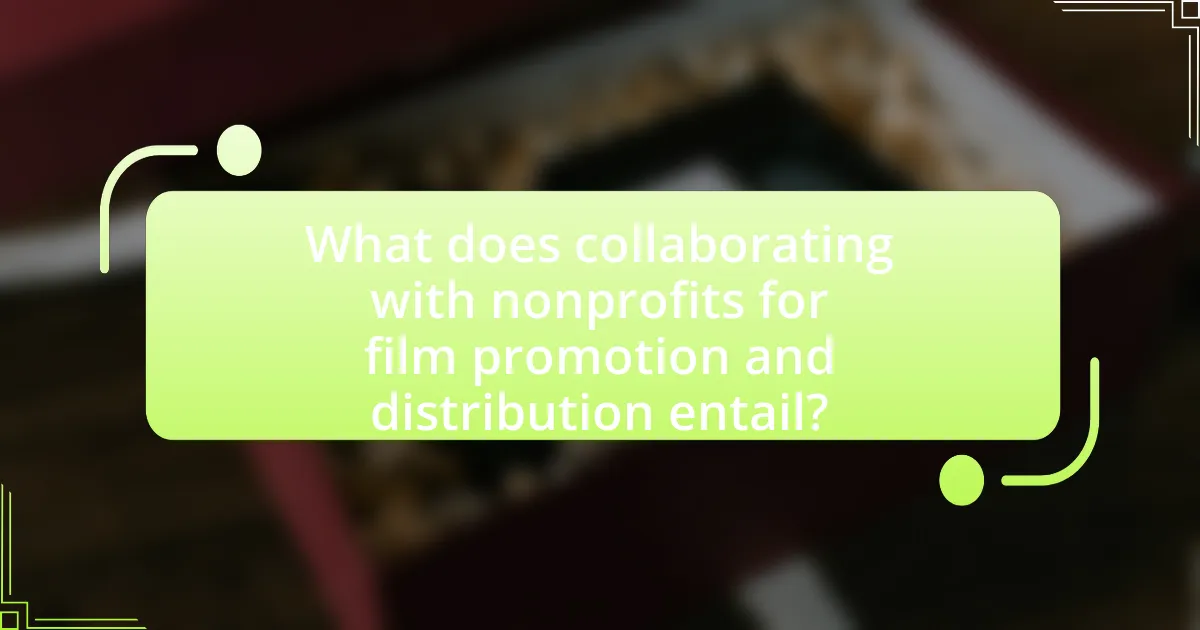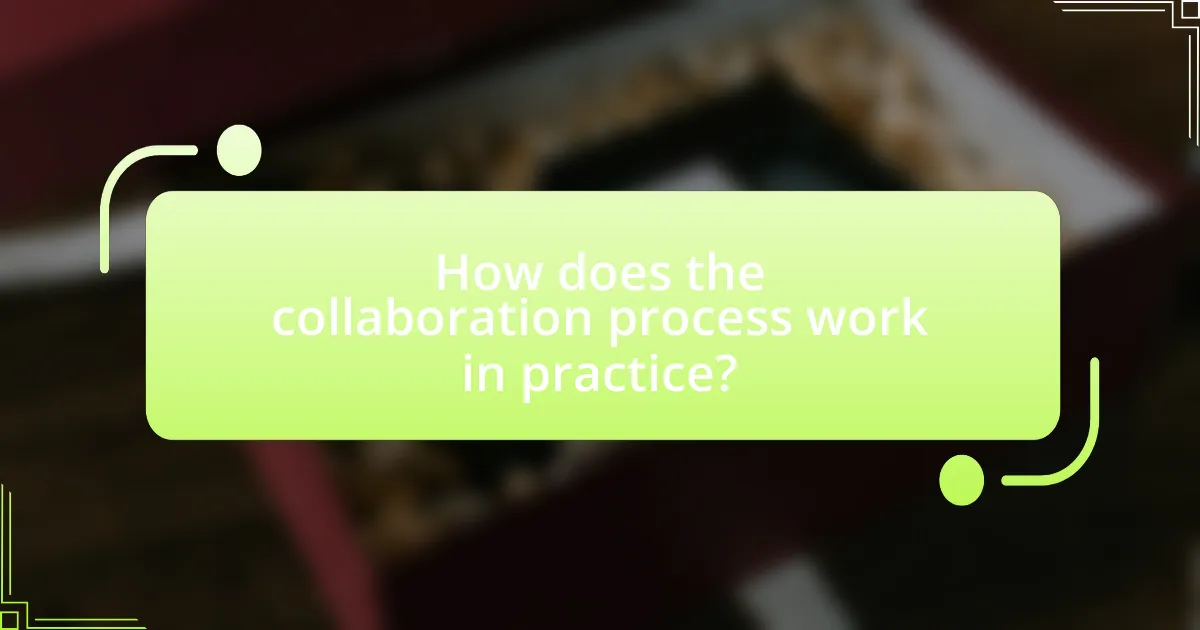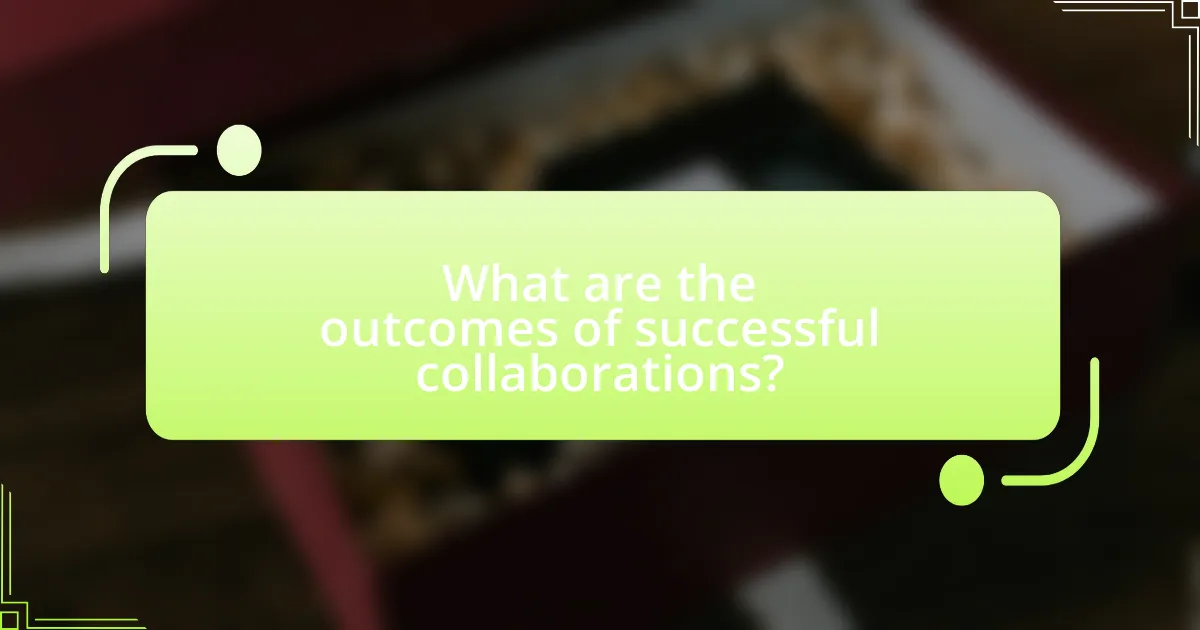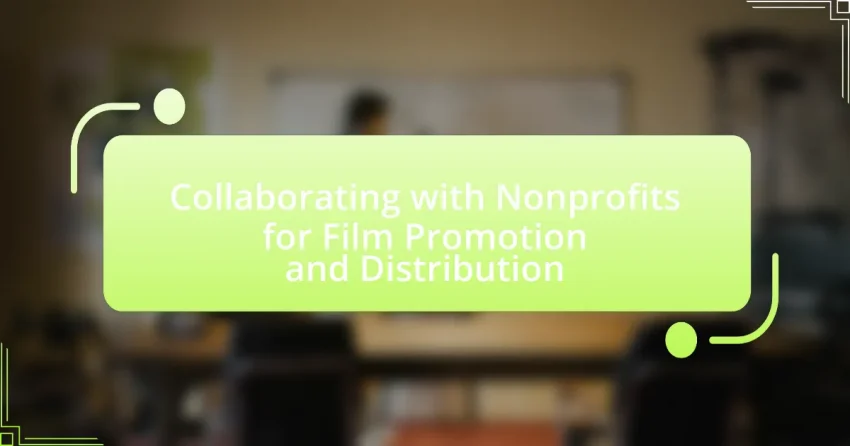Collaborating with nonprofits for film promotion and distribution involves leveraging the nonprofit’s resources, networks, and mission alignment to enhance a film’s visibility and audience engagement. Filmmakers can benefit from access to funding, established credibility, and targeted outreach through partnerships with nonprofits focused on community development, environmental conservation, and social justice. Effective collaboration strategies include clear communication, defined roles, and shared goals, while challenges may arise from misaligned objectives and resource constraints. Successful partnerships can lead to increased audience reach, enhanced credibility, and greater social impact, with measurable outcomes such as audience engagement and fundraising success.

What does collaborating with nonprofits for film promotion and distribution entail?
Collaborating with nonprofits for film promotion and distribution entails leveraging the nonprofit’s network, resources, and mission alignment to enhance the film’s visibility and reach. This partnership often involves co-hosting events, utilizing the nonprofit’s communication channels, and engaging their audience to create a shared impact. For instance, films addressing social issues can benefit from nonprofits’ established credibility and community trust, which can lead to increased audience engagement and support. Such collaborations can also provide access to funding opportunities, as many nonprofits have grants available for projects that align with their goals, thereby facilitating broader distribution and promotional efforts.
How can filmmakers benefit from partnerships with nonprofits?
Filmmakers can benefit from partnerships with nonprofits by gaining access to funding, resources, and audiences aligned with their film’s themes. Nonprofits often have established networks and credibility in specific communities, which filmmakers can leverage for outreach and promotion. For instance, a documentary addressing social issues can partner with a nonprofit focused on that cause, enhancing visibility and impact. Additionally, collaborations can lead to shared marketing efforts, increasing the film’s reach and engagement. According to a study by the University of Southern California, films that engage with nonprofit organizations often see a 30% increase in audience attendance, demonstrating the tangible benefits of such partnerships.
What types of nonprofits are most suitable for collaboration?
Organizations focused on community development, environmental conservation, and social justice are most suitable for collaboration with film promotion and distribution efforts. These nonprofits often have established networks and audiences that align with film themes, enhancing outreach and engagement. For instance, community development nonprofits can leverage films that highlight local issues, while environmental organizations can promote documentaries addressing climate change. Collaborating with these types of nonprofits can lead to increased visibility and impact for both the film and the nonprofit’s mission, as evidenced by successful partnerships in past film festivals and community screenings that have driven awareness and action on critical issues.
How do nonprofits enhance film visibility and outreach?
Nonprofits enhance film visibility and outreach by leveraging their established networks and community engagement strategies. They often have access to specific target audiences that align with the film’s themes, allowing for tailored promotional efforts. For instance, nonprofits can organize screenings, discussions, and events that not only showcase the film but also foster dialogue around its subject matter, thereby increasing audience engagement. Additionally, partnerships with nonprofits can lead to cross-promotion through their marketing channels, which may include newsletters, social media, and community events, amplifying the film’s reach. Research indicates that films associated with nonprofit organizations often experience higher attendance rates and greater media coverage, demonstrating the effectiveness of these collaborations in enhancing visibility and outreach.
What are the key strategies for effective collaboration?
Key strategies for effective collaboration include establishing clear communication, defining roles and responsibilities, and setting shared goals. Clear communication ensures that all parties understand expectations and can address issues promptly, which is crucial in nonprofit collaborations where resources may be limited. Defining roles and responsibilities helps to avoid overlap and confusion, allowing each participant to contribute effectively based on their strengths. Setting shared goals aligns the efforts of all collaborators, fostering a sense of unity and purpose. Research indicates that organizations with well-defined collaboration strategies achieve higher success rates in joint initiatives, as evidenced by a study published in the Journal of Nonprofit Management, which found that 75% of successful collaborations had clearly articulated objectives and communication plans.
How can filmmakers identify potential nonprofit partners?
Filmmakers can identify potential nonprofit partners by researching organizations that align with their film’s themes and target audience. This involves examining nonprofit missions, values, and existing projects to find synergies. For instance, filmmakers can utilize databases like GuideStar or Charity Navigator to access information on nonprofits, including their focus areas and community impact. Additionally, attending industry events, networking with nonprofit leaders, and leveraging social media platforms can facilitate connections with organizations that share similar goals. This targeted approach ensures that partnerships are mutually beneficial and enhance the film’s outreach and impact.
What steps should be taken to establish a successful partnership?
To establish a successful partnership, organizations should first identify shared goals and values that align with their missions. This alignment fosters mutual understanding and commitment, which are essential for collaboration. Next, they should engage in open communication to discuss expectations, roles, and responsibilities, ensuring that all parties are on the same page. Additionally, creating a formal agreement outlining the partnership’s terms can help prevent misunderstandings and provide a clear framework for collaboration. Regular check-ins and evaluations of the partnership’s progress are also crucial, as they allow for adjustments and improvements based on feedback. Research indicates that partnerships with clear objectives and ongoing communication are more likely to succeed, as evidenced by studies showing that organizations with defined goals experience higher satisfaction and effectiveness in collaborative efforts.
What challenges might arise in these collaborations?
Challenges in collaborations with nonprofits for film promotion and distribution include misaligned goals, communication barriers, and resource constraints. Misaligned goals can lead to conflicts in vision and priorities, as nonprofits may focus on social impact while filmmakers prioritize commercial success. Communication barriers often arise due to differing organizational cultures and terminologies, which can hinder effective collaboration. Resource constraints, such as limited funding and manpower on the nonprofit side, can restrict the scope and effectiveness of promotional efforts. These challenges can ultimately affect the success of the collaboration and the film’s outreach.
How can filmmakers address potential conflicts of interest?
Filmmakers can address potential conflicts of interest by establishing clear guidelines and transparency in their collaborations with nonprofits. This involves openly disclosing any financial relationships or affiliations that may influence the film’s content or messaging. For instance, filmmakers should create written agreements that outline the roles, responsibilities, and expectations of both parties, ensuring that the nonprofit’s mission aligns with the film’s objectives. Additionally, filmmakers can seek independent reviews or feedback from third parties to assess the integrity of the project. This approach not only fosters trust but also mitigates the risk of bias, as evidenced by industry practices where transparency has led to more ethical collaborations and positive audience reception.
What are common misconceptions about working with nonprofits?
Common misconceptions about working with nonprofits include the belief that they lack professionalism and that they are solely reliant on volunteer labor. In reality, many nonprofits operate with structured management and employ skilled professionals to achieve their missions. According to the National Council of Nonprofits, over 1.5 million nonprofits in the U.S. contribute significantly to the economy, employing approximately 12.3 million people, which demonstrates their professional capacity and economic impact. Additionally, while volunteers play a crucial role, many nonprofits also rely on paid staff to ensure effective program delivery and organizational sustainability.

How does the collaboration process work in practice?
The collaboration process in practice involves establishing clear communication, defining roles, and aligning goals between filmmakers and nonprofit organizations. Filmmakers typically initiate partnerships by identifying nonprofits that share similar values or themes relevant to their film, followed by discussions to outline mutual benefits and responsibilities. For instance, a filmmaker may provide exclusive screenings or promotional materials in exchange for the nonprofit’s outreach efforts to their audience, thereby enhancing visibility for both parties. This structured approach ensures that both the film and the nonprofit can effectively leverage each other’s strengths, leading to successful promotional campaigns and increased audience engagement.
What are the stages of collaboration between filmmakers and nonprofits?
The stages of collaboration between filmmakers and nonprofits typically include initial outreach, partnership development, project planning, execution, and evaluation. Initially, filmmakers reach out to nonprofits to identify shared goals and interests, establishing a foundation for collaboration. Next, partnership development involves formalizing the relationship through agreements that outline roles, responsibilities, and expectations. During project planning, both parties collaborate on the film’s content, messaging, and distribution strategies to ensure alignment with the nonprofit’s mission. Execution follows, where filmmakers produce the film while nonprofits may assist with resources, promotion, and community engagement. Finally, evaluation occurs post-release, assessing the impact of the film on the nonprofit’s objectives and the overall effectiveness of the collaboration. This structured approach ensures that both filmmakers and nonprofits achieve their respective goals while maximizing the film’s reach and impact.
How can initial meetings set the tone for successful partnerships?
Initial meetings can set the tone for successful partnerships by establishing clear communication, mutual understanding, and shared goals. During these meetings, stakeholders can articulate their expectations, values, and objectives, which fosters trust and alignment. Research indicates that effective communication in the early stages of collaboration significantly enhances relationship quality and project outcomes. For instance, a study published in the Journal of Business Research found that initial interactions characterized by openness and clarity lead to stronger partnerships and better performance metrics.
What role does communication play throughout the collaboration?
Communication is essential throughout collaboration as it facilitates the exchange of ideas, aligns goals, and fosters trust among partners. Effective communication ensures that all stakeholders are informed about project developments, roles, and expectations, which is critical in nonprofit collaborations where resources may be limited. Research indicates that organizations with strong communication practices experience a 25% increase in project success rates, highlighting the importance of clear dialogue in achieving shared objectives.
What tools and resources can facilitate collaboration?
Collaboration can be facilitated through tools such as project management software, communication platforms, and shared document services. Project management software like Trello or Asana allows teams to organize tasks and track progress, enhancing accountability and transparency. Communication platforms such as Slack or Microsoft Teams enable real-time discussions and file sharing, fostering quick decision-making and collaboration. Shared document services like Google Drive or Dropbox provide a centralized location for storing and editing documents, ensuring all team members have access to the latest information. These tools collectively enhance efficiency and streamline the collaborative process, making them essential for successful partnerships in film promotion and distribution with nonprofits.
How can social media be leveraged for joint promotion?
Social media can be leveraged for joint promotion by creating collaborative campaigns that engage both organizations’ audiences. This approach allows for shared content, cross-promotion, and increased visibility, as seen in successful partnerships like the collaboration between the film “The Hunger Games” and various charities, which utilized social media platforms to amplify their messages and reach wider demographics. By utilizing targeted hashtags, co-hosting live events, and sharing each other’s posts, organizations can effectively enhance their promotional efforts and drive engagement.
What platforms exist for sharing resources and information?
Platforms for sharing resources and information include social media networks, cloud storage services, and collaborative tools. Social media networks like Facebook, Twitter, and LinkedIn facilitate the dissemination of information and resources among users. Cloud storage services such as Google Drive and Dropbox allow users to store and share files easily. Collaborative tools like Slack and Trello enable teams to communicate and manage projects effectively. These platforms are widely used for sharing information and resources in various contexts, including nonprofit collaborations for film promotion and distribution.

What are the outcomes of successful collaborations?
Successful collaborations between filmmakers and nonprofits lead to increased audience reach, enhanced credibility, and greater impact on social issues. These partnerships allow filmmakers to tap into the nonprofit’s established networks, resulting in broader distribution channels and access to targeted demographics. For instance, a study by the Stanford Social Innovation Review found that collaborations can amplify messaging, with 70% of nonprofits reporting increased visibility for their causes through partnerships with media projects. Additionally, these collaborations often foster community engagement, as nonprofits mobilize their supporters to participate in screenings and discussions, thereby creating a more informed and active audience.
How can collaborations enhance film distribution channels?
Collaborations can enhance film distribution channels by leveraging the networks and resources of nonprofit organizations to reach wider audiences. Nonprofits often have established relationships with community groups and access to specific demographics, which can facilitate targeted outreach and engagement for films that align with their missions. For instance, a documentary addressing social issues may partner with a nonprofit focused on those issues, allowing the film to be screened at community events, thereby increasing visibility and attendance. This strategic alignment not only broadens the film’s audience but also fosters community support and advocacy, as evidenced by the success of films like “Won’t You Be My Neighbor?” which utilized nonprofit partnerships to enhance its distribution and impact.
What metrics can be used to measure the success of these partnerships?
Key metrics to measure the success of partnerships with nonprofits for film promotion and distribution include audience engagement, fundraising outcomes, and social impact. Audience engagement can be quantified through ticket sales, social media interactions, and attendance at events, indicating the reach and resonance of the film within the community. Fundraising outcomes can be assessed by the amount of money raised for the nonprofit through film-related initiatives, showcasing the financial effectiveness of the collaboration. Social impact can be evaluated through surveys and feedback from the audience regarding changes in awareness or behavior related to the nonprofit’s mission, providing insight into the partnership’s effectiveness in driving meaningful change.
How do successful collaborations impact audience engagement?
Successful collaborations enhance audience engagement by leveraging the strengths and networks of both parties involved. When filmmakers partner with nonprofits, they tap into the nonprofit’s established community connections and credibility, which can significantly broaden their reach. For instance, a study by the Stanford Social Innovation Review found that collaborations between nonprofits and businesses can lead to a 25% increase in audience participation at events. This increase is attributed to shared resources, joint marketing efforts, and the alignment of missions, which resonate more deeply with audiences. Therefore, successful collaborations not only amplify visibility but also foster a sense of community and shared purpose, ultimately driving higher engagement levels.
What best practices should filmmakers follow when collaborating with nonprofits?
Filmmakers should prioritize clear communication and shared goals when collaborating with nonprofits. Establishing a mutual understanding of objectives ensures that both parties align their efforts effectively. Filmmakers must also respect the nonprofit’s mission and values, integrating these elements into the film’s narrative to enhance authenticity and impact. Additionally, filmmakers should involve nonprofit representatives in the creative process, allowing for valuable insights that can enrich the storytelling.
Furthermore, setting realistic timelines and budgets is crucial, as nonprofits often operate with limited resources. Filmmakers should also consider co-branding opportunities, which can amplify outreach and engagement for both the film and the nonprofit. Lastly, evaluating the collaboration’s impact through metrics and feedback can provide insights for future partnerships, ensuring continuous improvement in collaborative efforts.
How can filmmakers ensure alignment of values with nonprofit partners?
Filmmakers can ensure alignment of values with nonprofit partners by conducting thorough research on the nonprofit’s mission, values, and past initiatives. This alignment is crucial for effective collaboration, as it fosters a shared vision and enhances the impact of the film project. For instance, filmmakers should engage in open discussions with nonprofit representatives to clarify objectives and expectations, ensuring that both parties are on the same page regarding the project’s goals. Additionally, reviewing the nonprofit’s previous partnerships and community engagement efforts can provide insights into their operational ethos and priorities, further solidifying the alignment of values.
What are the key takeaways for sustaining long-term partnerships?
Key takeaways for sustaining long-term partnerships include clear communication, mutual benefit, and shared goals. Clear communication fosters trust and ensures that all parties are aligned on expectations and objectives. Mutual benefit is essential, as partnerships thrive when both sides gain value; for instance, nonprofits can enhance their visibility while filmmakers can reach wider audiences. Shared goals create a unified direction, allowing partners to work collaboratively towards common outcomes. Research indicates that partnerships with defined objectives and regular check-ins are more likely to endure, as they adapt to changing circumstances and maintain engagement.
